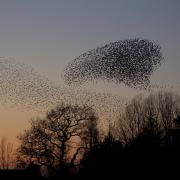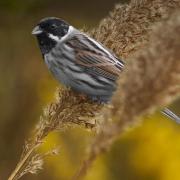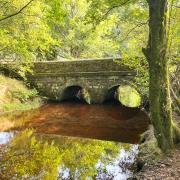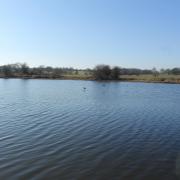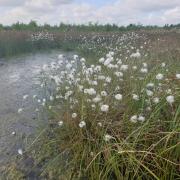These magnificent birds have been breeding again in Lancashire but their fragile future has drawn in everyone from Chris Packham to the bosses of M&S. Mike Glover reports

Amanda Anderson doesn’t have to go far to see the enormity of the job she has taken on. She just has to look out of the windows of her barn conversion home office near the three counties borderland.
From one window she can gaze across Lancashire’s Bowland Knotts. From another she sees Yorkshire’s Pen Y Ghent. And on a clear day she can see the Lakeland Fells.
Not only does she have amazing views, she is also in touch with the landscape she passionately fights to preserve. Amanda has recently taken over as the first woman director of the Moorland Association, which over 850,000 acres of globally-recognised heather moorland, swathes of it in Lancashire.
While the 42-year-old mother-of-two will be looking after the interests of some of earth’s most fragile landscapes, the new job also pitches her into the middle of a heated debate about shooting estates and their impact on bird of prey populations. This is because her role also means she represents the English grouse shooting industry, worth £67 million a year. The shooting of red grouse, a major part of the activity carried out in Lancashire, has been headline news with wildlife presenter Chris Packham spearheading a campaign to ban certain types of grouse shooting to protect hen harriers from persecution by over-zealous gamekeepers.

Meanwhile, Marks & Spencer is refusing to sell red grouse this season. ‘These are challenging times, not just for our organisation, but the countryside as a whole,’ says Amanda.
Opponents claim there has been a decline in raptor numbers and this has been caused by the actions of landowners. She refutes this, saying official figures have show an increase in bird of prey numbers. She accepts that there have been times when what she describes as a handful of moorland gamekeepers have over-stepped the mark and been prosecuted.
However, she believes the hen harrier is a special case and she is adamant that the conflict can be resolved. She and the association are supporting a proposed scheme where landowners accept one pair of hen harriers per 20,000 acres and, if this number rises, chicks would be taken under licence to an aviary and the reared birds would be released into areas with suitable habitat but few grouse moors.
‘Moorland management for red grouse is excellent for all sorts of ground nesting birds, with waders being up to five times more abundant on grouse moor compared to moors without gamekeepers. Breeding records for merlin - our smallest bird of prey - are four times more numerous.

‘The abundance of these species, including grouse, can be attractive to birds of prey along with the habitat which is carefully managed to provide a mosaic of different heights and types of vegetation benefiting different species. They are very good places to go and see birds of prey.
‘I live on the edge of the Forest of Bowland surrounded by grouse moors and am lucky enough to see buzzard, red kite, sparrowhawk, merlin, hen harrier, kestrel, barn owl, short eared owl and little owl. That assemblage is, in my book, the best indicator of good conservation and gamekeeper attitude.’
The country’s first hen harrier chicks for two years recently fledged in north Lancashire, with two of three successful nests on grouse managed land, producing 11 young .
Amanda said her organisation welcomed the spotlight on harriers and condemned wildlife crime. ‘We need to build on this year’s successful breeding to springboard a wider recovery. The Defra-led Joint Recovery Plan, if implemented, would see the growth of a sustainable population of hen harriers without jeopardising driven grouse shooting, along with the environmental, social and economic benefits it delivers. The RSPB has yet to give it their full support. ‘Three parts of the recovery plan tackle any wildlife crime against the birds and three parts deal with the sustainable growth of the harrier population.’
Another key element is the nest management scheme taken from tested conservation techniques in France. ‘This would see hen harrier chicks in nests 10km from another nest reared in an aviary and released six weeks later in suitable habitat. This will help ensure harriers nest without impacting on ground nesting birds on which they prey, especially red grouse. The English grouse shooting industry provides vital income for conservation and supports over 1,500 jobs.’
Not only has Government realised how precious the marshy peat-lands and heather-strewn uplands are for wildlife, landscape and local employment, but there is an awareness of how the various ecologies fit together.
Last winter’s high profile floods across great swathes of the South of England gave extra evidence of the repercussions of getting rid of bogs, flood-planes and other water-absorbing features up in the hills.
Anyone managing land has strata of rules and regulations to meet national and European standards, which are particularly onerous when Areas of Outstanding Natural Beauty or Sites of Special Scientific Interest are involved. This is just sort of land owned by members of the association. And Amanda knows that there are still battles to be fought: over maintaining habitats for birds of prey; the ancient tradition of burning off heather; and the use of chemicals on bracken.
‘I fervently believe that careful management of heather moorlands, with grouse shooting as the lynchpin, can produce the best benefits for wildlife, landscape and local economies,’ she says.
‘This iconic land has safeguarded three quarters of the world’s remaining heather moorland and is a haven for exceptional and endangered species. Without the grouse industry this landscape would just not exist.
‘The sport of shooting grouse is unique in the world. That is the driver of all the habitat management that goes on.’ She urges people not to ‘dismiss all the good that comes from that just because we don’t like the method of harvest.’
‘The gains are enormous - water in the taps; vital ecosystems; essential habitats and the protection of flora and fauna.’
The MA’s ambitious aims include seeing 250,000 further acres of heather moorland regenerated, boosting birds, plants and animals. Amanda believes this will help Britain reach its Biodiversity 2020 goals.
Her great grandfather Archie Ritchie was the first game warden of Kenya in East Africa, and pioneered the idea of wildlife national parks.
Amanda gained a Masters degree in aquaculture, honours degree in zoology, plus a further degree in post-16 education. For 15 years she was partner in a marketing and communications company, based near Clitheroe, and she has managed courses at Myerscough College.
All of which has prepared the way for her to lead the fight for the preservation of the landscape just outside her office window.














